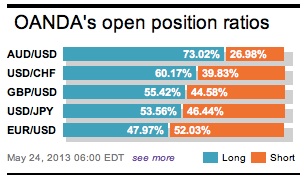The markets are aware that too much free or nearly free money is going to cause trouble. Japan’s equity indices saw it first hand this week when their main stock market fell -7.9% during one session. All one has to do is look at our central banks – they seem to be single-mindedly focusing on CPI and jobs while totally disregarding the by-product of quantitative easing – asset inflation. Not making decisions any easier is when a central bank, like the Federal Reserve, is having trouble explaining itself.
Monetary policy action has the Bank of Japan and the Fed creating “money monsters pits.” Any intraday equity index drop greater than -5% is a stern market reminder that once a specific asset class has been crammed with copious amounts of cash, then the withdrawal of profits from a move towards “less” accommodation signal, like Bernanke hinted to mid-week, can and will always cause a massive headache to investors because of the “immense volatility” that the rush creates.

In Japan’s case, capital markets were lucky that they did not have the firepower to continue the equity asset destruction during the European session. The mostly positive Euro-PMI’s this week, combined with the on target UK GDP headline print, has been allowed to smother ‘helicopter’ Ben’s ‘taper’ talk. When there is policy confusion investors are reluctant to react. Yesterday’s better than expected US weekly claims and new home data seem to have been set aside for future consideration by the market – otherwise it would have created a stronger demand for the ‘buck’ outright.
Nowadays, Central Banks words are probably more important than their actions. With benchmark rates being so low there is little room for manipulation – hence more rhetoric as a policy tool. On this point, US policy makers seem to have been making a meal of verbally singling their intentions – miscommunicating their goals. Fed Chair, Ben Bernanke, told Congress on Wednesday that they ‘could’ start reducing its $85 billion-per-month bond-buying program at one of its “next few meetings” and cautioned that policy makers were reluctant to move aggressively or prematurely. This blatant intention somehow has been confused by a number of other signals sent by the Fed and Ben himself in recent weeks.

Starting in early May, a policy statement suggested that the Fed’s next move could be “either up or down.” Even this week’s Fed minutes on the most recent policy meeting suggested that some policy makers “might want to reduce the program as early as June” and finally, Ben’s prepared congressional testimony this past Wednesday, also implied he was “reluctant to move.” Three different messages in the span of a few weeks and US policy makers supposedly have one intention.
There are many ways to deliver ‘one message’, but the Fed seems to have defied the odds and delivered many interpretations on many occasions. It’s no wonder that investors seem to have been caught in the headlights on more than one occasion – this mid-week’s equity price action is a prime example. Stock prices rallied when the Fed initially sounded reluctant to start reducing the size of the monthly bond purchases, fell when Ben looked like he was embracing the idea, and eventually fell when the Fed’s minutes revealed a variety of views on the timing. Communication creates expectations and getting out a clear message matters. Rhetoric is supposedly the central banker’s most powerful tool, especially now that rates are at or close to zero.
The global equity rout can probably take a breather after this morning’s German business confidence print (105.7 vs. 104.4). The Ifo business confidence index rallied this month after two consecutive months of declines and beat analyst’s forecasts for an unchanged reading. The 17-member single currency has found some support on the back of the release, as investors seem to be assuming that buoyant consumers and rising business confidence will translate into economic growth in H2 for the country that is labeled Europe’s “backbone.” The may mean that the ECB will be keeping rates at +0.5% for now.

The markets initial intention was probably to fade any EUR rally, however, this morning’s action has been mainly EUR/Cross buying by Middle-East interest on the back of a stronger than expected Ifo German release. There seems to be a strong interest to let some EUR’s go close to the psychological 1.3000 option barrier target. However, investors should be weary of the US and UK’s upcoming long weekend – as traders square their books, volume usually becomes a premium while some of the price action makes little sense.

Other Links:
The Capitulation Trade Has Short Yen Positions Worried
Dean Popplewell, Director of Currency Analysis and Research @ OANDA MarketPulseFX
This article is for general information purposes only. It is not investment advice or a solution to buy or sell securities. Opinions are the authors; not necessarily that of OANDA Corporation or any of its affiliates, subsidiaries, officers or directors. Leveraged trading is high risk and not suitable for all. You could lose all of your deposited funds.


